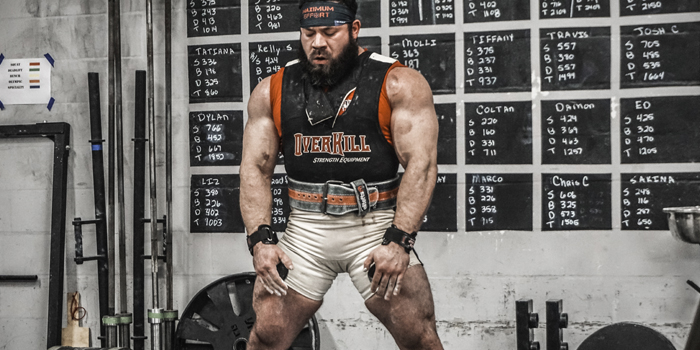
Introduction
Not too long ago, I wrote an article and program called 12-Week Omni-Contraction for Powerlifters based on the principles of Christian Thibaudeau's Omni-Contraction system. The system includes three training days; an eccentric-, isometric-, and concentric-focused day.
Although I think the program I wrote is very good and can help many lifters get stronger, I should've focused more on why training all contractions is important. Understanding the principles allows you to take the information and use it however you want or with whichever system you want—way more important than blindly following a program.
So, for now, here are my two cents on why training each contraction benefits both powerlifting and athletics!
Eccentrics
Eccentrics—Absorption
"You can't produce what you can't absorb."
Christian Thibaudeau
When I put a bar on my back for a squat, I envision myself as a stiff coiled spring with a load pressing down on me. As I'm going down with the weight, I'm storing all this energy from the load compressing down on the spring (my body). When I reach the bottom, I use the stored energy to explode out of the hole to complete the lift.
However, imagine you have all this energy stored at the top, but as you go down, you, the spring, aren't stiff enough to withstand all the pressure pushing down. Therefore, some of the energy is leaking out of the system. When you get to the bottom, you don't have enough energy saved up to come up with the weight.
This explanation describes the importance of training the eccentric portion of movements. A lack of eccentric strength can result in the "loss" of energy being stored as you descend, ultimately limiting your ability to showcase your strength and remain injury-free.
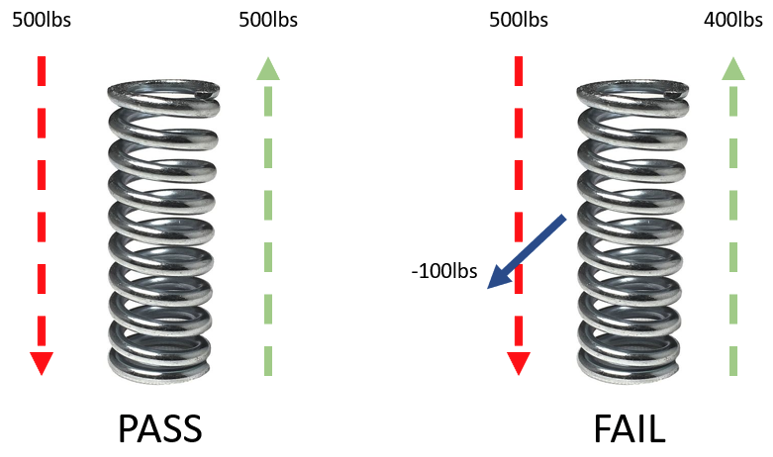
Eccentric training is all about increasing our ability to absorb forces. Our body has a system called the Golgi Tendon Organ (GTO) that is in place to shut down force production when it senses too much tension. It's essentially a safety mechanism to prevent us from producing a force our bodies aren't capable of withstanding. One way we get stronger is by silencing the GTO and minimizing its inhibition. In simple terms, you tell it, "Shut up, I'm safe," so you can push more weight. You might not be able to lift more weights immediately, but being stronger eccentrically creates a greater POTENTIAL for force production in the future. It raises your ceiling for how strong you can get.
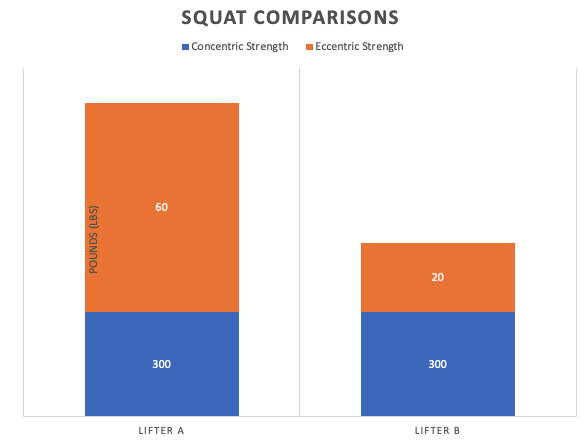
Let's compare two lifters, both with a 300-pound squat. The only difference between the two is that Lifter A is 60 pounds stronger eccentrically (120%) than concentrically, which is better than Lifter B, who can only handle 107% of his 1RM eccentrically.
This means that Lifter A has a stronger base to build his squat on, whereas Lifter B is running out of room.
In this case, Lifter A has enough eccentric strength and should focus more on his concentric strength, with potential isometric work to focus on specific weak points. On the other hand, Lifter B would benefit greatly by bringing up his eccentric strength. That way, the gap between the two will widen and provide greater room for improvement.
A final major point for training the eccentrics as a powerlifter is the improvement of lifting technique when a lift is performed slowly on the way down. Often, a lift can be more challenging on the way up simply because the position on the way down wasn't correct. Performing the eccentric portion slowly WITH load allows you to consciously think about your positioning and engrains the movement pattern. It has also been said that different neural pathways are associated with the different contractions and rep speeds. By performing a slower tempo, the neural connections for the descent strengthen, thus improving movement proficiency.
For the powerlifter still not convinced about training eccentrics, Ed Coan used a 10-second descent (Super-Slow Eccentrics) on squats to practice technique, and Josh Bryant used Supra-Maximal Eccentrics for his bench press. Both were world-class lifters (just saying).
Now for athletics, training eccentrically is even more important.
Think about why the Nordic Hamstring exercise is so popular for training the hamstring and preventing ACL injuries. If you've never done the exercise before, the eccentric portion is so difficult on the hamstrings that it's hard to do correctly compared to a normal Glute Ham Raise. This is primarily why the exercise is so highly recommended. The hamstrings become eccentrically very strong, enabling them to absorb high amounts of force, ultimately protecting the knee joint while playing sports.
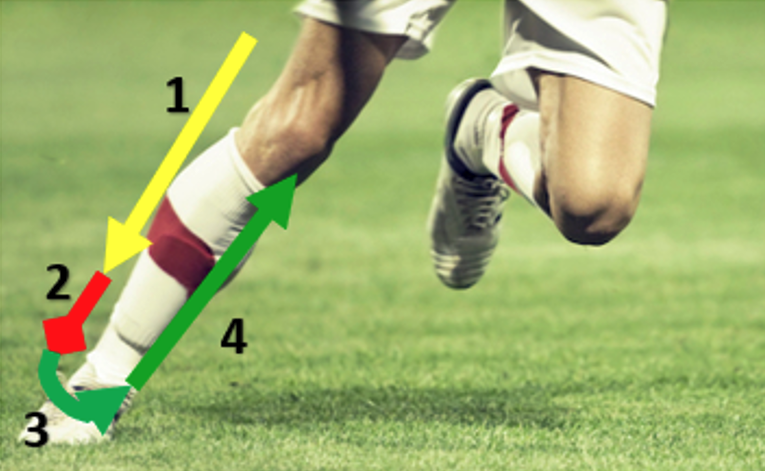
For jumping and running performance, think about what happens every time you land to stride, jump, or change direction. A force must be absorbed before a force can be produced. If the absorbing force is too great, the Golgi Tendon Organ will limit the force produced and cause a slower and less powerful concentric action. This is a primary reason for the careful selection of box height when performing Depth Jumps. Above a certain height, the force upon landing is too great that the reactivity off the ground becomes too slow, and the power produced after landing diminishes.
How to Test Eccentrics
Eccentric Strength Deficit
Take 125% of your 2RM (real or estimated) and perform two reps with an eight-second eccentric and no concentric.
Either overload with eccentric hooks or have two side spotters to help lift the weight up. If you cannot complete the two reps with an eight-second tempo and the prescribed weight, you lack eccentric strength and should spend some time building it up. I would not recommend this for advanced powerlifters as the load used can be dangerously heavy (an 800-pound squatter would need to test with 1000 pounds).
Add Slow Eccentrics and Compare
Add some slow eccentric (four to six seconds) training and compare the load used to the load used during a normal tempo lift.
This is more of a quick and easy test if you don't want to try the test mentioned before. From experience, if you haven't done eccentric training in a while (or ever), you'll most likely see a big reduction in weight used due to the increased time under tension. You should allocate some training volume to training eccentrics.
How to Use Eccentrics
For strength, shooting for roughly a time under tension of 20-30 seconds is optimal. Any longer than that, muscle fatigue will elevate quickly, and the weight used to get the prescribed number of reps will be too low to have a strong strength effect.
For muscle hypertrophy, anywhere from 40-60 seconds is what I recommend. Athletes or lifters that are more fast-twitch (fatigue-intolerant) are best to stay around 40 seconds, whereas those that are fatigue-resistant can go up to 60 seconds.
Typical progression to increase eccentric strength and later have it transfer to performance:
- Phase 1 – Slow Eccentric (four to five seconds) – Ex. 5x5 – 50x1 Tempo
- Phase 2 – Super Slow Eccentric (six to 10 seconds) – Ex. 6x3 – 80x1 Tempo
- Phase 3 – Overspeed Eccentric (Bands as accommodating resistance) – Ex. 8x2 – x 0x1
- *Younger, less experienced lifters (<three years training) can benefit greatly from simply doing four-second eccentrics in each phase as it ameliorates technique and motor control.
- *If eccentrics are performed slowly for too long, the athlete may have difficulty doing faster eccentrics (which is critical for power production) and fully utilizing the stretch reflex. Be sure to finish a training cycle with at least three to four weeks of fast eccentrics for the improvements made over the last two to three phases to transfer over to sporting performance.
Isometric
Isometric—Transition
"Weak things break."
Louie Simmons
If eccentrics are about absorbing forces, isometrics are about maintaining strength as you transition between positions or between eccentric and concentric action. The reason for training isometrically is very similar to that of eccentrics: to prevent any energy leaks. Let me give a couple of examples:
Powerlifter Performing the Bench Press
By training eccentrically, they have gained the ability to absorb greater loads. However, they may still have trouble off their chest because they aren't able to maintain tension and stability as they transition between the eccentric and concentric motion. The inability to stay "tight" results in a leak of energy rather than being stored as the weight is being lowered, thus causing them to fail on the lift going up.
Football Running Back Cutting to Avoid a Tackle
The first phase of performing a change of direction is the absorption of force (eccentric), but imagine they can't transition (isometric) quickly enough out of the hole to change direction. Even though the transition period is a fraction of a second, a slower change of direction will most likely result in the player getting tackled.
There are a couple of other reasons to train isometrically. In the gym, isometrics can be valuable to reinforce technique on specific lifts, especially with younger athletes or athletes newer to training. I say newer because brand-new athletes may have a lot of trouble at first due to the lack of coordination or just general strength. For example, it is common to see athletes drop and lose tension in the bottom of the squat, causing the lift to be much harder than it should be. Simply pausing two to three seconds in the bottom will force them to maintain tension and teach proper bracing technique. Why?
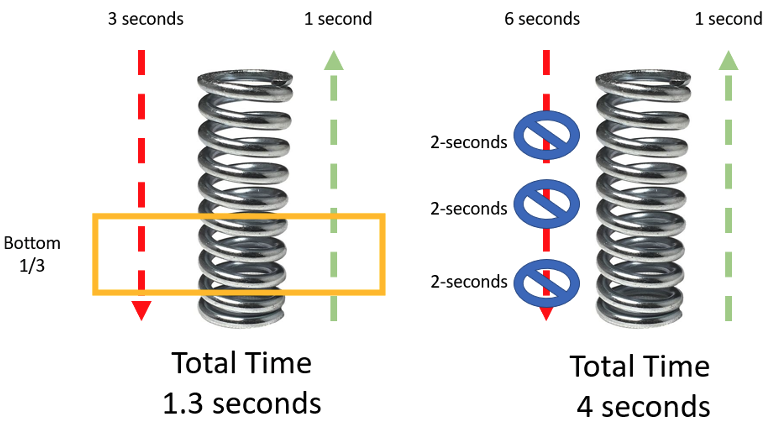
If you think about the time an athlete will spend in a specific position for a lift, let's say the bottom third of the squat with a normal tempo of 3-0-X-1, the athlete may spend just over one second per rep in the bottom position. But let's say you add a two-second pause at both the halfway point and at the bottom position. The time spent in the bottom third per rep goes up to approximately four seconds. That means your brain and tissues are being trained more in their weakest position, ultimately leading to a greater adaptation than had they just performed the reps under a normal cadence.
Isometrics are also great for training weak or vulnerable ranges of motion, both by improving neurological drive and training the tissues.
Functional Isometrics (aka Isometronics aka Hoffman Method) involves an athlete performing multiple repetitions in a specific range of motion. This results in the tissues getting more exposure to that specific range.
One of my favorite isometric training methods is Overcoming Isometrics, which is when you push or pull against an immovable object. I like this method so much because it is a maximal (most often) contraction and creates a strong neural drive to the tissues at that specific range (plus or minus 15 degrees). This can be great for breaking training plateaus, potentiating more explosive movements, or preventing injury (check out the Functional Range Conditioning© principles). Our bodies are much smarter than we think. When it hasn't been trained to be strong or to produce high levels of force in certain ranges, it will either stop contracting or lead to injury.
A powerlifter looking to increase his bench in the bottom range may use Overcoming Isometrics just above his chest after his main bench work. A soccer player may use a barbell split squat Overcoming Isometric to improve single leg strength.
The main purpose of these isometrics is to strengthen positions an athlete is weak in so there is minimal energy lost as they transition between positions or between the eccentric and concentric actions.
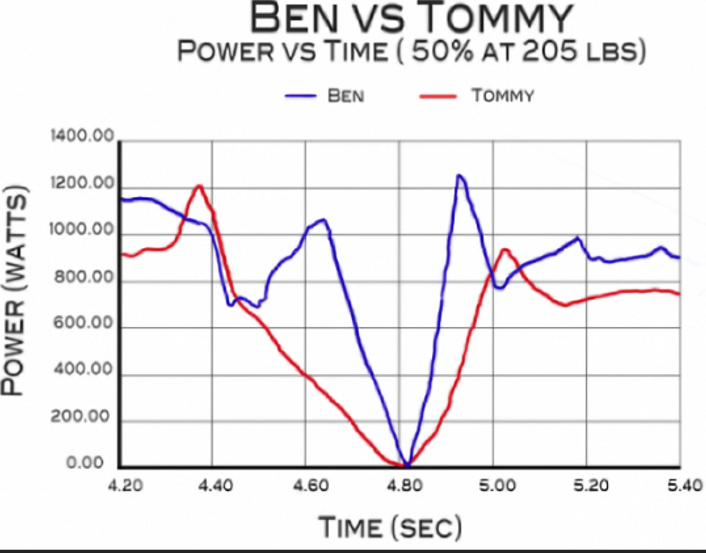
How to Test Isometrics
Force Plate
I don't have experience (yet) using Force Plates because I don't have one, but based on the work of Cal Dietz in his book Triphasic Training, Force Plate readings could reveal an athlete's isometric ability. In the classic example of Ben vs. Tommy found in the book, look how quickly Ben (blue), a world-class athlete, goes from Eccentric (downwards) to Concentric (upwards) compared to Tommy (red), a collegiate athlete.
- That rapid transition between absorbing force and producing force is one of the reasons why Ben was a much better thrower.
Coaching Eye
- Does the lifter lose proper positioning during portions of the lift or have an obvious sticking point?
- 5-10-5 Agility Test
- How quickly does the athlete change direction? Are they fast or slow to transition from absorbing to producing?
How to Use Isometrics
Yielding Isometrics or Static-Dynamic
- Short (2-3 seconds) Duration – Reinforce technique and build capacity to maintain strength and tension in certain positions
- Long (>10 seconds) Duration – Maintenance of tension, build tissue resilience
- Very Long (>1 minute) Duration – Improve tendon stiffness and load capacity; Lengthening tissues/flexibility (>2 minutes)
Overcoming Isometrics
*Maximal – 3-6 sets of 1-3 reps of 3-6 seconds
- For overcoming a sticking point, include after the main compound work as a secondary movement. It is a Max Effort method, so start off on the lower volume end.
- For sports performance, I like using them in a complex to potentiate more explosive movements (ex.
Overcoming Isometric Deadlift x 6sec, into Broad Jumps x 3 reps).
*Submaximal – 1-3 set of 1-3 reps of >15 seconds
- The greater the duration, the lower the intensity or intent to move the immovable object.
- It can be used for hypertrophy training as part of a superset complex to increase time under tension (ex. Overcoming Iso Bench Press – Bottom Position – 1 x 30sec superset Flat DB Press – 1 x 6-8 – 3010) or to help learn how to contract specific muscles in a lift (ex. Emphasizing the triceps during a bench press).
Concentric
Concentric—Production
Training the concentric portion or not focusing on the eccentric or isometric actions is always more enjoyable, normally because more weight can be used. This can be good because it can make you stronger, but it could also hinder progress long-term. Just going into the gym maxing out every time might not be the most optimal for building your strength.
Yes, the Max Effort method is very effective for building strength by recruiting the most motor units, but it is also the most demanding method on the nervous system to recover from. However, using heavy partials (concentric-only) for multiple repetitions to strengthen a weak point can be extremely valuable. For sports, I love using heavy partials to potentiate my athletes before a more explosive movement. Sled pushing, sled dragging, jumping, and medicine ball throwing are also all great tools to build a stronger, more resilient, and explosive athlete.
I spent the first two articles talking about the importance of training eccentrically and isometrically. They were articles in themselves because they form the strongest base or potential for strength and power development in the long run. However, athletics and powerlifting depend on concentric power, many of which also require a strong stretch reflex. Only training slow eccentrics and isometrics can potentially hinder performance if not used correctly.
That is why I believe all three need to be trained within a training cycle for the training of the different actions to feed off one another.
Conclusion
Now, how does it all go together? How do you implement it into your own training or the training of your athletes? It depends entirely on where your athlete is training-wise, what they need, and how the principles can fit into your training system or philosophy.
The Omni-Contraction System by Christian Thibaudeau is one very good way to organize the training so that all contractions get trained; however, it might not suit all athletes.
Triphasic Training by Cal Dietz and Ben Prentiss' Quad Current systems are other ways of implementing all three contractions in a training plan.
For simplicity's sake, I like to think of it this way: Eccentrics and Isometrics are for BUILDING, while Concentrics are for TRANSFERRING.
How much volume of "building" versus that of "transferring" does your athlete need?
Here's a very good example of what I saw this summer with two of my athletes:
Athlete A – 25-year-old professional ice hockey player that can lunge 225 pounds for six reps per leg and has close to a 30" vertical jump on a bad day.
Athlete B – 17-year-old high school ice hockey player that squats just over 225 pounds for one rep and has a 20" vertical jump.
Guess which athlete should spend more time building with slower eccentrics and isometrics and which athlete could do more transfer training…
Now I'm not saying Athlete B won't do concentric work like heavy partials, repetition maxes, or plyometrics. I just look more at the ratio between building and transfer work (Concurrent training?...). For some of my athletes, this is how their summer was planned out:
xxxx
| Building | Transferring | |
| Accumulation 1 | 4 | 0 |
| Intensification 1 | 2 | 2 |
| Accumulation 2 | 2 | 2 |
| Intensification 2 | 0 | 4 |
Is this the "best" system? I don't know, but it's the best way I thought of organizing the training with the circumstances I had. Whatever training system you follow, the principles of training the eccentric and isometric actions can be applied. For those that are huge fans of the Westside System (as myself), here's how it can be structured:
Max Effort Day – Building
- Primary Lift – Max Effort Lift (Concentric, Eccentric, Isometric)
- Secondary Lift – Isometric or Eccentric focus
Dynamic Effort Day – Transferring
- Primary Lift – Speed work (Concentric or Eccentric – Bands)
- Accessories – Hypertrophy work (Concentric)
| Max Effort Lower | Dynamic Effort Lower |
| High Bar Pause Squat – 3RM SSB Squat to Box – 3 x 3 – 6-second eccentric Accessories | SSB Box Squat vs. Bands – 8 x 2 Rack Pull – Knee Height – 3 x 5 Accessories |
"Just when your body has all the answers, it's time to change the question."
Louie Simmons
Add variety to your training by including different rep speeds and emphasizing different contractions to build a stronger, more resilient athlete.
Header image courtesy of Meana Albersworth

Max Daigle is a strength and conditioning coach working with elite-level athletes at Axxeleration Performance Center in Montreal, Canada. After completing his bachelor's degree in physiology, he is pursuing a master's degree in exercise science from McGill University.










1 Comment